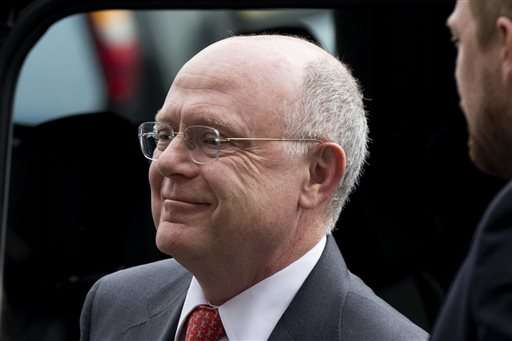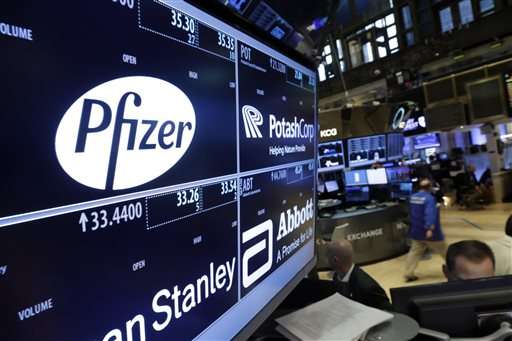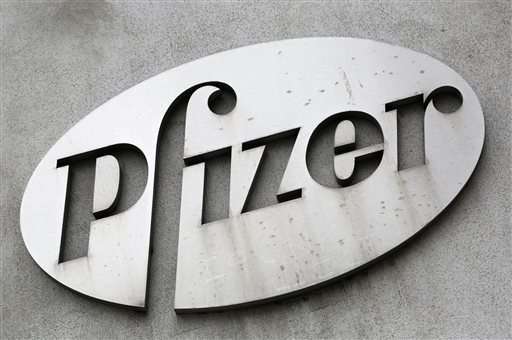Pfizer doubling patient income limit for free drug program

As the furor over soaring U.S. prescription drug prices escalates and outrageous price hikes by several smaller drugmakers give the entire industry a black eye, the biggest U.S.-based drugmaker is expanding financial assistance to patients.
Pfizer Inc. says it's doubling its income limit for people to receive dozens of its medicines without a copayment because more patients need help. Patients' insurance plans generally must then pay the bulk of the drug's cost. Some critics say this isn't the best way to keep drugs affordable for everyone.
"It's not addressing the price of the drug," Clare Krusing, a spokeswoman for the trade group America's Health Insurance Plans, said Thursday.
"This is the wrong approach when you consider the cost impact that patients have on the back end," said Krusing.
She said insurance plans eventually raise patients' monthly premiums or other payments to compensate. One study of California plans early this year found most increases have been tiny—so far.
Krusing also noted widely used drugmaker coupon programs like Pfizer's usually are only temporary. They cover patient copayments for a specific brand-name drug or limit them to $50 or so.
Such programs can increase overall medication costs, particularly if they nudge patients to stay on brand-name drugs over cheaper generic versions. However, medicines often prevent expensive complications and hospitalizations.
Pfizer's move comes amid fierce criticism by patients and politicians, as well as a growing number of government investigations, of six-figure list prices for new medications for cancer, hepatitis C and rare diseases, and huge price hikes on old ones with little or no competition.
Turing Pharmaceuticals, which recently hiked by 5,000 percent the price for the only drug for a life-threatening parasitic, has been accused of price gouging, along with Valeant Pharmaceuticals International Inc. and a handful of other companies. Meanwhile, a surge of mergers of brand-name and generic drug manufacturers threatens to further limit competition, the primary control on prices in the U.S.
Drugmakers now face a "wave of hearings and public beatings" over exorbitant drug prices, said pharmaceuticals analyst Erik Gordon, a professor at University of Michigan's Ross School of Business.

"If you're Pfizer, you want to look like you've made a voluntary, charitable move before you get beat up" in a congressional hearing, Gordon said.
In an exclusive interview, Pfizer Chief Executive Ian Read told The Associated Press the New York company isn't boosting assistance due to heightened scrutiny of prices, but because more and more patients can't afford needed medicines.
"There are people who are falling through the cracks through no fault of their own," Read said. "As a stopgap, we're willing to do this."
Read, the immediate past board chairman of industry trade group Pharmaceutical Research and Manufacturers of America, cited insurance plans now shifting more costs onto patients, plus some Affordable Care Act exchange plans and insurance formularies that exclude pricier prescription drugs.
While insurers get big discounts off drug list prices, plans increasingly require patients to pay a large percentage of the price for ultra-expensive drugs—and cover all medicine and care costs until they've met their plan's annual deductible or out-of-pocket maximum, often many thousands of dollars.
That's impossible for many patients early in the year, when holiday bills arrive, said Marc Boutin, CEO of the National Health Council, which represents patients, insurers, drugmakers and other groups. He said deductibles should be spread out over each year.
Most drugmakers offer patients financial assistance, particularly when pricey new drugs are first launched and the companies are trying to win over doctors and patients, to recoup their $1 billion-plus in development costs.
Also, the industry's 20-year-old Partnership for Prescription Assistance connects patients to about 475 assistance programs, nearly 200 of them run by drugmakers. Visits to its site, www.pparx.org , rose 13 percent from January through October, to about 587,000,

Under the Pfizer RxPathways program, the company will cover patient copayments for 44 medicines for both uninsured and underinsured patients earning up to four times the federal poverty level, up from twice that level. The new limits are $47,080 annually for a single person and $97,000 for a family of four.
The program covers many popular Pfizer brands: pain relievers Celebrex and Lyrica, smoking cessation aids Chantix and Nicotrol, Prevnar 13 pneumococcal vaccine and erectile dysfunction pill Viagra. Nearly 20 additional Pfizer medicines, including numerous expensive cancer drugs, already required no copayment for patients making up to four times the poverty level.
Last year, the RxPathways program helped about 350,000 patients. Pfizer expects to help a few hundred thousand more than that next year. Between 2010 and 2014, the program helped nearly 2.5 million people get more than 30 million Pfizer prescriptions worth more than $7 billion at list prices.
There's no sign other drugmakers are expanding their assistance programs, and Gilead Sciences Inc., the maker of new hepatitis C medicines with list prices around $90,000 for a course of treatment, recently decreased the number of patients it is helping, forcing more costs onto insurers.
Merck & Co., the second-biggest U.S. drugmaker by revenue, since 2010 has offered assistance to patients with incomes up to five times the federal poverty level for some of its most-expensive medicines and four times that level for the rest.
Asked why Pfizer doesn't just reduce prices for its drugs in the U.S., where medicines generally cost a few times more than in other wealthy countries, Read said high prices are needed to fund innovative research on future drugs. That's long been the industry's mantra.
"Our prices, we think, are appropriate," Read said. "We can't lower the prices enough for (many patients) to afford it."
More information: www.PfizerRxPathways.com
© 2015 The Associated Press. All rights reserved.

















